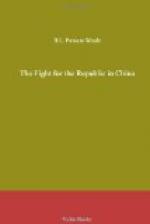When the terms of this proposed agreement were communicated to the Tientsin Consulate by the French Legation the arrangement did not please the French Consul-General, who was under transfer to Shanghai and who proposed to settle the case to the satisfaction of his nationals before he left. There is absolutely no dispute about this fact either—namely that the main pre-occupation of a consular officer, charged primarily under the Treaties with the simple preservation of law and order among his nationals, was the closing-up of a vexatious outstanding case, by force if necessary, before he handed over his office to his successor. It was with this idea that an ultimatum was drawn up by the French Consul General and, having been weakly approved by the French Legation, was handed to the Chinese local authorities. It gave them a time-limit of twenty-four hours in which to effect the complete police evacuation of the coveted strip of territory on the ground that the delay in the signature of a formal Protocol had been wilful and deliberate and had closed the door to further negotiations; and as no response came at the end of the time-limit, an open invasion of Chinese territory was practised by an armed French detachment; nine uniformed Chinese constables on duty being forcibly removed and locked up in French barracks and French sentries posted on the disputed boundary.
The result of this misguided action was an enormous Chinese outcry and the beginning of a boycott of the French in North China,—and this in the middle of a war when France has acted with inspiring nobility. Some 2,000 native police, servants and employes promptly deserted the French Concession en masse; popular unions were formed to keep alive resentment; and although in the end the arrested police were set at liberty, the friendly intervention of the Allies proved unable to effect a settlement of the case which at the moment of writing remains precisely where it was a year ago. [Footnote: A further illustration of the action of French diplomacy in China has just been provided (April, 1917) in the protest lodged by France against the building of a railway in Kwangsi Province by American engineers with American capital,— France claiming exclusive rights in Kwangsi by virtue of a letter sent by the Chinese Minister of Foreign Affairs to the French Legation in 1914 as settlement for a frontier dispute in that year. The text of the letter is as follows:
“The dispute that rose in consequence of the disturbance at the border of Annam and Kwangsi has been examined into by the Joint Committee detailed by both parties concerned, and a conclusion has been reached to the effect that all matters relating to the solution of the case would be carried out in accordance with the request of Your Excellency.




